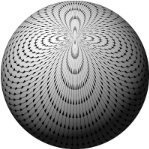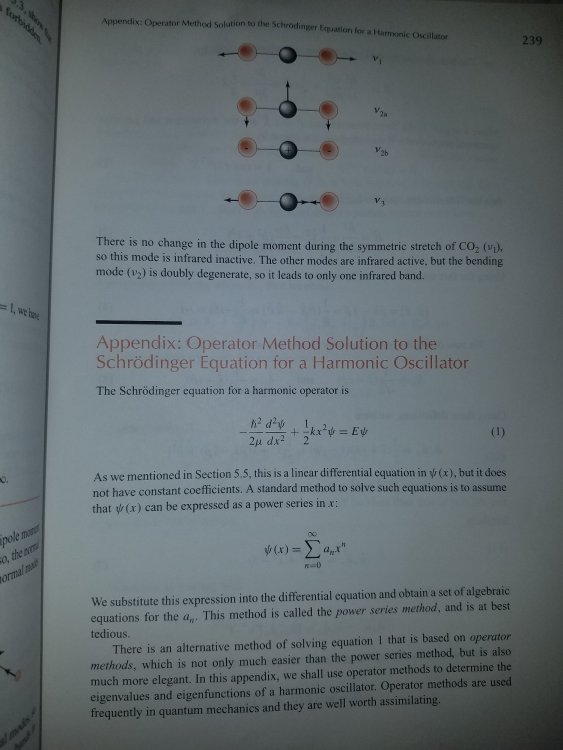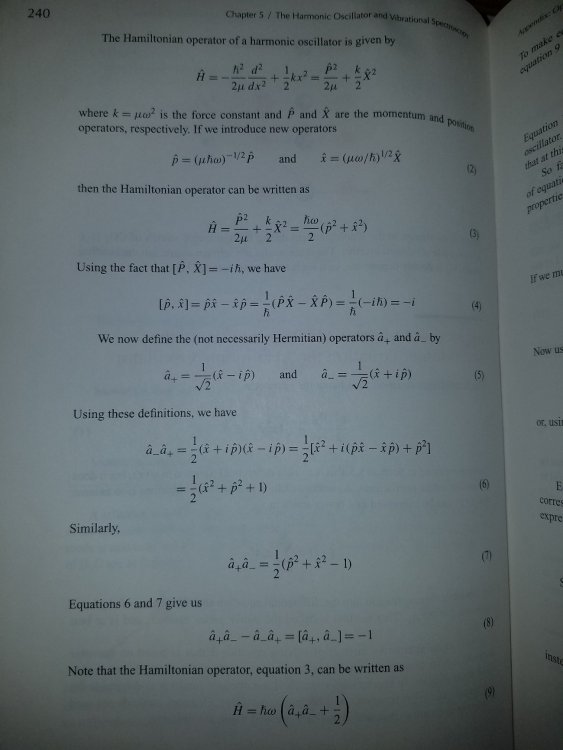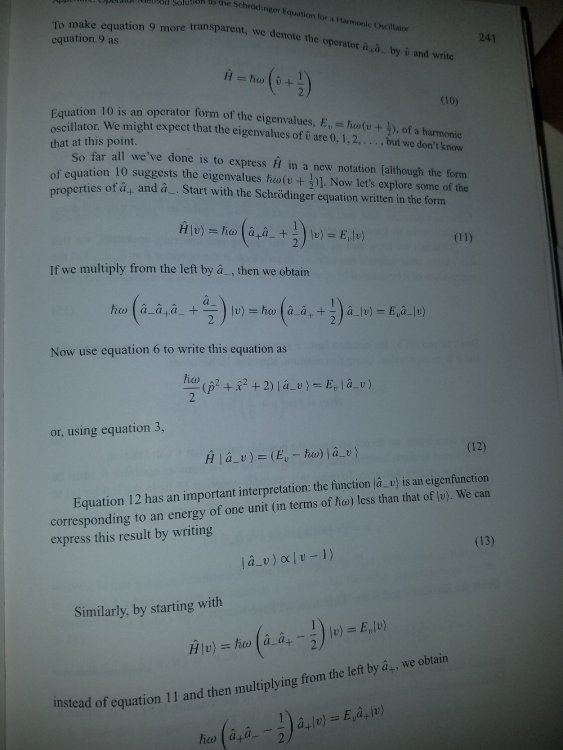-
Posts
286 -
Joined
-
Last visited
-
Days Won
1
Content Type
Profiles
Forums
Events
Everything posted by NTuft
-
No need to apologize, and that is funnier now... I apologize for getting defensive, but given some time I think I was being somewhat irrational, and I ascribe that to 1) being told what to do, with a negative connotation and 2) making claims about what I was trying to do. I clarify that what I was trying to do was argue in support of a position that takes issues with part of the premise of the question, which was the first thing I brought up. I don't think I'm making a special plea to get anywhere in the argument, to get to the answer. Rather, the question of the thread is "who created god?". I am re-formulating the logic as "A=A, god is that which is uncreated". So, in effect what I'm trying to get around is the premise of the question. This is to bring about the possible answer that "no-one did"... to paraphrase a blinded cyclops. It may not even be necessary. Given the premise, I'd say no-one did, or religionists did; so I'm not sure I'm getting us towards an answer, but I was trying to raise points that I thought had been overlooked by my reading. I'd grant you that this is what we're trying to do with the scientific method. If the instruments were all blinded cyclopses, however, there is an inherent reading error which cannot be removed by accumulating data from different instruments. I do not necessary think that myself, it is just again to try and illustrate. I also agree that is has done a great job, the method par excellence. I do not think I am resorting to an argument that I or one's self can be the only thing knowable, but rather that if humans are fallible (a la the blind cyclops analogy), or if we are being deceived (a la Descartes demon), then there is likely some inherent error in our sciences. Please, do not be so certain on the middle point, retain some doubt. I really can't see how the last point is solipsism either. I may be Polyphemus, tricked by Odysseus; I do not necessarily trust myself or mode of thinking, and I think that is the opposite of solipsism. I am not contributing to a definitive answer, but rather saying I entertain both answers, which could be a form of stonewalling or useless philosophizing. Also I may have set up a straw-man (named Chuck D.) regarding evolution (or the evaluation of empiricism), but it is often brought up as some body of proven fact when there are arguments from biochemical complexity that muddy the waters with regards to the likelihood of random processes having sufficient explanatory power. There were some allusions along the lines of, "evolution can explain..", in my prior reading of the thread, and I wanted to point out a problem with that. I doubt the existence of God. Why is he playing hide-and-seek, or peekaboo? Telling (believable) lies, and yet having to be trusted?? Childish things. I don't want to believe, I want to know: any ideas for a testable hypothesis? I will grant it is hard to fathom something that would be beyond our level. A difficult task to view from all perspectives! I think we should seek to verify everything for ourselves ("make up your own mind"), and to do that we must try to entertain different possibilities or perspectives. I do applaud your two posts, also... Now we're getting sort-of Meta.
-
That was from me for marshalling the same elsewhere. Your conduct in this thread has been despicable. The posting zapatos references somehow manages to mention irrelevant transgender issues and then accuse the staff of being poisoned by the PC woke virus? Hogwash. Unlike MigL I'd be fine with you following through on leaving.
-
I introduced two terms to the discussion, and then provided two or three commonly known examples from religions to try and illustrate the terms. If you think that question was earnest, why is it so unspecific? I have to bear a demand for burden of proof on what point, exactly? This isn't Meta. I'm not here for the likes.
- 51 replies
-
-1
-
Ookay. In indirect fashion at the end I elaborated on the ideas of immanent vs. remote. I don't feel it obligatory to elaborate on terms that are readily available to be defined by a search. And I don't accept the question as though he's asking on behalf of a group of hillbillies who have limited computer time or speed at the local library or something. That is the question of the thread, and I have to disagree that since it is made explicit it is not a form of special pleading, being that the exception being declared defines the issue under argument. As an exercise in abstraction, let's examine empiricism. I'd say results of empirical science follow from an initial measurement or observation, and deductions then made to explain those observations or measurements. There is a small leap of faith made in granting that the instrument of observation or measurement has been calibrated precisely against an objective standard. Here if our instrumennt is human perception or reasoning we take it that these are not fallible or that enough observations and deductions agreed upon as reasonable constitutes sufficient support. By assuming that a result of epmiricism, like Darwin's theory of evolution, is based on precise or objective data is making a special plea for the results of a science that has not performed sufficient validation of it's base method -- being that it always relies on observation, human vision (which no doubt arose from random point mutations in the chemoreceptors of amniotes), or reason, which may be error prone. I'm not trying to fool anyone, nor evangelize to hillbillies. Although if there are any Mohammedans in the Hills, the 99 attributes or names of God also speaks to immanent vs. remote. Why you want to act aggrieved and insist that I elaborate on things such as that is beyond me. Well reasoned I'd say, and important to delineate that it may be a conception for explanation that is being examined; wholly equally weighted conclusion based on evidence that the concept is a construct of the human mind, IMO.
- 51 replies
-
-1
-
I am not so sure. The implication is that the special exception is part and parcel of the definition. Only that if people created G-d/gods it is an "immaterial" creation. No. If a clock-work universe were designed and then the guy (or possibly Descartes' demon) walked away it may be impossible to discern the hand which wrought it out. "who created god?" is also a loaded question.
- 51 replies
-
-2
-
An unchecked quip from some negative emotion, as I'm quite attached to my pet theory. To continue "flying by the seat of my pants" I bandy about a posteriori findings as though I knew what I was talking about at the time. Would you recommend any books on Physics? From @Genady I picked up mention of The Road to Reality by R. Penrose.
-
From a simple viewpoint, if we are assuming a value for P>0, an increasing volume (i.e. universe expansion), and conservation of mass (amount of substance, n); from PV=nRT , the increasing V may necessitate an increasing temperature, or a decreased mass density \(p\) = mass/V , if we can equate n to density as mass/V; the mass density is now negative in change from what it was before the expansion in volume? This brief exchange (link is to full thread) may be relevant: Physics Forums - Negative kinetic energy? That points to this (which I am not through with) Lecture I: Constrained Hamiltonian systems (Courses in canonical gravity) - Yaser Tavakoli, Dec. 15, 2014 I will look to read your paper, good work on presentation here.
-
The functions that satisfy the Laplace equation for spherical harmonics look a lot like our electron orbitals in Chemistry. I guess we have 3-Dimensional problems in chemistry, but not physics. Those 3 also necessary in logic, and your contribution is much appreciated. I did not see your reply until after replying. Thanks. The link to another line to follow up on is helpful.
-
I think an idea would be that God is the uniquely uncreated or self-created. But which came first, the turtle or the egg? This and other discussion pointing out "people did" brings to my mind the concept of an egregore: Which idea I think implies a certain materiality or existence of thought, the existence of "consciousness", which topic is a slippery eel... Also I think an aspect of theology to consider is immanent vs. remote. Judaism I think is largely concerned with making Yahweh immanent in the world. Christianity, or Pauline Christology, developed what I conceptualize as a semi-remote Tri-une God of "The Trinity": the mysterious aspect of which is that it can be self-creating through interaction of its constituent parts. May be the Absolute is further remote from the trinity, itself a unity. An eel egg, obviously. I would like to know who created the bacterial flagellum, or the ATP-proton pump. I don't think Chuck D. can rap his way out of a paper bag. Although, there sure is a lot of work done on that line.
-
In this way, you at least broached the subject. I am still hopeful you will expertly quash my amateur mathematical adventure. At this point I needed to be familiar with split complex numbers, with j2 = +1 , and I was not familiar with that. You may not have to do anything. Thanks for taking some time to look at it, even if it is a nuisance. P.s. : https://funkyenglish.com/idiom-throw-spanner-works/
-
That the equations hold through using members of a set from i' as a value for i. As I understand it, the Riemann function can output the prime numbers by definition in a way, showing their distribution, with non-trivial values always 1/2 real part. The quaternion assignments, for example, as an extension of the complex numbers have a real component, and three complex components, all selected values of i=sqrt(-1), and it's non-commutative rules (as though they were time-ensconced components), or require taking vector quotients for space translations... Again, essentially that most all equations should hold. Since you asked about complex calculus, I figured we'd take a function and see how it works through calculus with hyperbolic trigonometry and geometry.
-
"There is a connection between physics and complex calculus, provided by harmonic functions in two-dimensional problems." Can you explain that: harmonic functions, a la on the unit sphere, with real clear triangles? @joigus, Hello, good day, What if the Riemann zeta function has primes distributed with (1/2) real part because of the way i is being used as a 'spanner' in the works? As a placeholder it's made complex numbers a sort of math that can hold with limiting the nature of the imaginary component; or is it a component inseperable from an extra dimension like time, and so splits from the real number line for its expression? If complex math uses prime numbers under the square root operation in place as i', multiplication by the complex conjugate could still return results, and in particular the geometric morphisms of rotation on the complex plane, that are reducible like what is done currently with i as an operation placeholder, scaling the unit circle. By Euler's equation we graph the triangular relations on a 1-length legged triangle in a sort of polar graphing for trigonemtric relations, on what's a unit circle bounded above and below by magnitudes of i from the approachable limit, 0, (0 being defined as a limit) or the asymptotic region; on a hyerbolic complex graph, with the hypberbola and conjugate hyperbola not centered on a unit circle's central (asymptotic) discontinuity (the eccentricity defining the circle): but, in its place an ellipsoid shape (ecc.= ?), bounded on the "real" axes by the 1/4 root of i' and with the upper and lower bounds imaginary parts 1/2 roots of i': the hyperbola gives us the logarithm's decay of exponentiation, and maps exponentiation by the euler number e base. So that map is extended to make hyperbolic angle or rapidity exponentiated with now harm to the triangles: but the triangles add to less than 180 on interior angles measured normally... Again, in summary, the distribution of primes is best explained by explaining how complex math can use all such numbers as i, and the distribution of primes having (1/2) real part is a function of using +1 or -1 (which we will define as primes). Or, square root of -1, properly speaking: so we would have to map rules for exponentiations of i' now as a set of primes that is being alternated between values of +i', -i', +"1", -"1", by the operations of complex math. This looks like incorporating quaternion math or octonion math with the "+1s" and "-1s" let's call the approximation (i.e. the square root operation after carry-through) of the prime number: an irrational number we're not sure about, one which I think the set of which forms a relative uncountability between reals and complex numbers.
-
I am thinking that everything is torque-ing, and multiplying (or defining directionality in the same direction as force applied) by a "dimensionless angle" re-vivifies an aspect of directionality in 3-D of all KE; spin? @swansont, Wow! Thank you! I think this is the best lesson on learning calculus; I ought to review it again and again. What better way than with real world-scaled models to illustrate what calculus is doing on a function that describes motion??? I will refer to the degree of freedom that torque implies: multiplying the units by a dimensionless quantity (perhaps rapidity needs units?) comes through with implied directionality again, as from vectors that's a bugaboo... I think with quaternions we can translate around self-refential centers in 3-D, what with the extra "degree of freedom"? I need to read your post more thoroughly, And try to figure out what @exchemist is saying, exactly. No I do not understand time translation symmetry, but I doubt it. Also, we are assuming a constant, non-interactive mass? Bah. I think "the most zeroest of relative momentum frames" would be needed to assess when if ever interconversion conservation of mass and energy is a "law"...
-
For a non-rotating rigid body or a point object, the directionality is built into the unit of the joule: But, yes, in this case it is a dot product, a scalar: so, I think a KE system accounting for objects experiencing rotational force does have a vector component, but do correct me if I'm wrong.
-

How to use the change of variables technique here?
NTuft replied to Dhamnekar Win,odd's topic in Analysis and Calculus
Itchy trigger finger: I want to integrate by parts... -
Reformulation: I don't even think I'm shaking the apple cart... We're coming down from what I would call the "compactified/enfolded/stacked" (undifferntiable?) 5th through 10th dimension of string theory within AdS/CFT. Coming from 5th I'm saying there is a number set, i', comprising the square roots of prime numbers. This is a subset that should exist as an algebra or conceptual geometry: it is a subset of irrational quadratics as mapped by the Minkowski ?(x) function. Here, with the set of sq. rt's of primes we can not SQR, as that is a non-linear operation, but I will say can multiply by self-same so as to obtain: i'*i' obtains the prime no.; i'*i'*i' yields the prime to the 3/2 power; i'*i'*i'*i' completes the prime squared: using these numbers we can define our natural or real numbers by the Fundamental Theorem of Arithmetic. (Conjecture) Similar to how i, the imaginary unit as sq. rt. of -1 serves as an "irremovable discontinuity", here, too, the i' sets can serve as objects for complex math. I also posit that the members of the set can be equated to Quantum Mechanical states normally comprised by the four quantum numbers by way of boundary conditions, perhaps specifically helical boundary conditions. I speculate that co-efficients for Energy equations are difficult to assign arbitrarily, but that yes we could borrow them wholesale from Classical Mechanics. Here, a series of differentiation operations on i' yield dyadic ratios (see ?(x) function) that can align with Kinetic Energy (1/2), Potential Energy (-1/4), and on further (3/8 , 15/16, divergence...); to various exponents, which may also relate (admittedly only by the appearance of similar numbers) to 1/2-integer assignments elsewhere. I think we can assume that if we are examining a QM system for description these variables can be added, as it's rather "open-frame". Yet, this is in AdS/CFT frame-work: constant, negative Gaussian curvature space. We go down through hyperbolic space: we map this with a complex hyperbolic graph that can be scaled by i' mappings, and the shapes we use are hyperbolic->conic sections, as needed, to form our geometry (I want molecular orbitals here). We are using quaternions, octonions, sedenions : these have various iterations of imaginary numbers: better our 'imaginary numbers' comprise rather the set of square roots of primes, because to split the prime by approximation presupposes we know both the signs of the multiplicator and multiplicand, which we cannot take for granted, or so I think. Again, now I want to be able to quantize a QM system by assigning 4 quantum numbers as defined by a helical boundary condition such as the mapping of a certain magnitude of i' to the complex graphing possibilities that describe the state in total. For emergent quantum gravity at 1D level, we have negative curvative arising from initial symmetry breaking of the stretching of the string, the seperation of the point charges, the ejection of two mass bodies): we go into 2D hyperbolics for consistency in negative curvatuve. So, 2 "gravitons" comprise our system that is now 2-bodied: the gravitational force between the bodies an inverse square of the distance (being able to be described by an i' value); for emergent quantum gravity.
-
Perhaps you are looking to deal in kinematics, and I am overcomplicating things. However, to impart a speed onto a mass (and you supposing this is a mass that has been put in motion, yes?) requires an application of force for it to acquire kinetic energy. Once it has been brought up to speed, there is not a constant force being applied; I conceptualize the force acting may now be zero.
-
Integrate over a section of the function that is describing the Work output. And so you are modelling a system that has no physical importance or corollary, it seems. Please explain. From a singular reference we would measure displacement, change of position, distance, as zero if it returned to its initial position, thus no work is seemingly done in the system; this is a common teaching point on a quirk about Work. No, kinetic energy is... let's say a function of momentum, a vector quantity. A seemingly 'conserved' physical quantity, too. A vector implies a magnitude (e.g. speed is a magnitude) and a direction. I think these are necessary complexifications. You keep bringing up "d/t", but even the classical mechanics you're looking to do here need for you to be familiar with d/dt.
-
Directionless points, or are we to assume they're "moving on parallel lines"?
-
I think power is the time derivative of work. In order to make the simplification like: you are presuming a constant force is being applied over a distance (I'd say change in position). When you want to take an instantaneous power output, I think it makes sense there is no conservation of energy. You'd need to extend the time frame, and perhaps incorporate the other present bodies and conditions to know how the conservation may or may not weigh out. As an exercise, can you tease out the difference between change of position vs. distance (e.g.: "Why can Work be said to be 0 despite obvious evidence to the contrary, in a self-referential frame?") and velocity vs. speed. You mention speed at one point and then use v in your equation: velocity implies a direction against a map, and a change in direction gives us an acceleration, so when you have your instantaneous speed this option for change of direction as acceleration is removed from the equation (i.e.: can be said to exist presumptively also in the case of a "point"..).
-
Here are pages 239-241 of McQuarrie, cited earlier, for educational purposes: We then proceed to use the Hamiltonian that has been derived from the Harmonic Oscillator. In doing so we've eliminated an 'imaginary unit', i term; I do not know here if i is a stand-in for "time", a la Relativity, or why this is used in QM equations. I am reading Relativity. I am not sure we can eliminate this term, and then go on to try and shoe-horn the Harmonic Oscillator's derived Hamiltonian to fit by Linear-Combinations-of-Atomic-Orbitals that can explain experimental data. It seems like something is simplified and lost, and there is a breakdown in being able to describe more complex multi-nucleon/electron atoms or even basic molecules, because we have to iterate out so much to describe each electron configuration. I do not think I understand and I need to review; I do not even know s . I for one do not agree that we can square the normalized Psi modulus as . This is I think what constitutes the "Born probabilistic interpretation." From Shpenkov, pg. 3 (see pg. 1 for "Physical meaning of imaginary unit, i", link to paper), it's noted: Shpenkov posits , for k=kinetic energy and p=potential energy. Also, using the classical wave equation for sound, with a constant value for the wave number, k = (/c), instead of a variable (as in the wave number k in the Schrödinger equation). Please see: anyflip.com link to: Important Results of Analyzing Foundations of Quantum Mechanics. Kreidik, L.G.; Shpenkov, G.P.; Shpenkov's wave model is apparently able to predict a periodic table of elements that closely aligns with the current table, and has other favorable results from his models but I have not read enough. -- From chalmers.se: Mathematical discovery could shed light on secrets of the Universe the paper: Emergent Sasaki-Einstein geometry and AdS/CFT from the write-up: From the paper (which is way beyond me in technical expertise) I have gathered that they've employed a complex cone in order to describe this emergent gravity mathematically. The proper placement of a negative fractional exponent (-(1/6), if I read it) allowed this to jibe with their calculations.
-
I say the positively charged proton exposed due to electrons orbiting a ways from that nucleon. I do not think this can be taken for granted, and the prior statement, "the internal structure of the nuclei has no bearing at all on this", actually follows from the second statement. Thank you. I need to review even spectral line data. And then to the Linear-Combinations-of-Atomic-Orbitals (LCAO). Even the basics of QM and the four numbers, which are describing the electrons... Thanks again.




